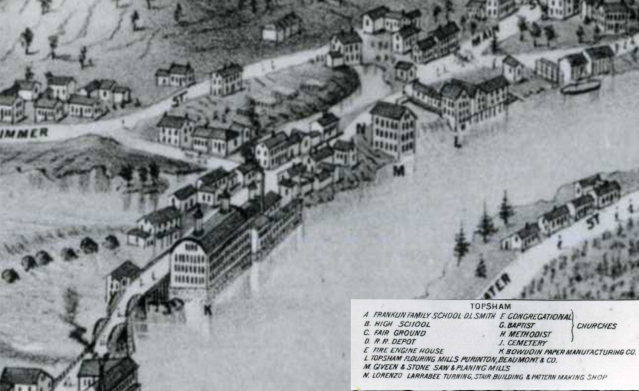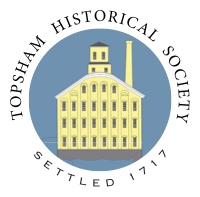
Mill island detail from 1877 Brunswick-Topsham
Although the Town of Topsham was officially incorporated in 1764, development began much earlier. In 1717, homesteads were built on 100-acre lots fronting the Androscoggin River while the first sawmills were built on the Cathance River. By 1753, the first wooden dam across the Androscoggin was constructed, the first of many to serve mills on the Granny Hole Stream. In 1796, a bridge linked Topsham with Brunswick, making this area of dams and mills the primary gateway to Topsham.
It became a natural place for development. An 1802 map shows 46 buildings, with 28 of which were homes. There were five mills, six stores, a cabinet maker’s shop, a blacksmith shop, and several other businesses as well as a courthouse and school.
The village streets were Elm Street, Winter Street (then called High Street), Main Street (built in 1790), Water (now Green Street) which was built in the late 18th century and Thompson’s Lane, which ran between Main and Green Streets. The mills were centered around Granny Hole Stream on Main Street near the bridge, but no churches had yet been built within the village.
Articles on the early history of Topsham suggest that from 1798 to 1808, and shortly afterwards leading up to the War of 1812 were some of the most prosperous years for the town as shipping and shipbuilding flourished in the area. In the early to mid-19th century, it was manufacturing businesses powered by water in the Lower Village which flourished.
The population doubled from 1802 to 1850, from about 1,000 to 2,010 people. This also was when the homes of the wealthy began to be separated from those with more modest means. A grand residence on an elevated terrace was the Federal style ideal, and several were built along Elm, Main, and Melcher Place.
As in so many New England communities, religion played a major role in the lives of Topsham residents. The Congregational Church was the “official” religion of Massachusetts, and Maine was part of Massachusetts until gaining statehood in 1820. In the 1830’s a new Congregational church (later used as a town hall) was built by Samuel Melcher III at the corner of Elm and Green Streets. It burned in the 1960’s. A new Baptist church was erected by Melcher on Elm Street in 1835 and stands today. The Free Will Baptist church on Winter Street was constructed in 1837 and demolished in the 1970’s. Another Christian-based sect got its start in the 1840’s in Topsham. Ellen White lived in Gorham but was visiting her friends, the Howlands, at 7 Elm Street in Topsham. It was here, in 1847, that she had the “vision” which confirmed her beliefs and established her as one of the founding members of the Seventh Day Adventist Church.
By 1853, the central village had grown to more than 150 buildings, and Federal style gave way to Greek Revival. The published Brunswick-Topsham bird’s eye view of 1877 shows the village south of Melcher Place largely as it exists today with about 180 buildings and three churches. The brick Bowdoin Paper Company mill was the largest building in town, with a railroad depot at the east end of the village.
Mills continued to play a role in the town’s development, and not just the paper mills along the Androscoggin. Feldspar was mined from local quarries, with a mill on the Cathance River and with the principal mill of the Maine Feldspar Company on the eastern end of Elm Street near the railroad tracks. It had the capacity to process 40 tons of spar per day and employed 75 people. At one time, Topsham produced 1/8th of the feldspar used in the US and 1/16th of that used worldwide.
Feldspar mining and mills also played a big role in the ever-changing immigrant population of Topsham. Italians, who knew the mining trade well, were brought over and lived in tent cities near today’s Tedford Road, often sending their earnings back home to families in Italy. French-Canadian families lived in the Topsham Heights up above the Androscoggin River but within walking distance of the mills on both sides of the river. A footbridge, known as the Swinging Bridge, made it much more convenient for the Catholic mill workers in Topsham to cross the river to attend Mass, spoken in French, at St. John the Baptist Church in Brunswick. In the nearby village of Pejepscot, eastern Europeans made up much of the community and worked in the paper mill on the Androscoggin River.
Less new construction occurred during the Victorian era, but Summer Street saw several houses in the Queen Anne style, including expanded and remodeled Federal style capes. Many older homes were “updated” with Italianate door hoods, bay windows and porches. Styles continued to change, but many of the original homes remained which is why today in Topsham’s historic district you’ll find a Federal home next to a Greek Revival with an Arts and Crafts bungalow nearby.
A prominent part of the town became the annual Topsham Fair, originally held every fall from 1856. Started by the Sagadahoc Agricultural and Horticultural Society, the early exhibitions featured livestock and produce, with handcrafts soon added. The Topsham Fair grandstand was built in 1864 and is still standing; it is listed on the National Register of Historic Places. The fair, now held the first week of August, continues to grow and is going strong as one of the state’s oldest agricultural fairs.
World War II and the Cold War brought military bases to the area, and many of the servicemen and women ended up staying in Topsham. The town has shifted from one with agricultural and manufacturing as its base to more retail but still with plenty of small businesses to keep it thriving. It’s a quirky, unique town which has reinvented itself several times, and is made up of many residents who can trace their roots back to the early beginnings of Topsham, along with many of us “from away” who love the small town feel and respect its ever evolving history.
